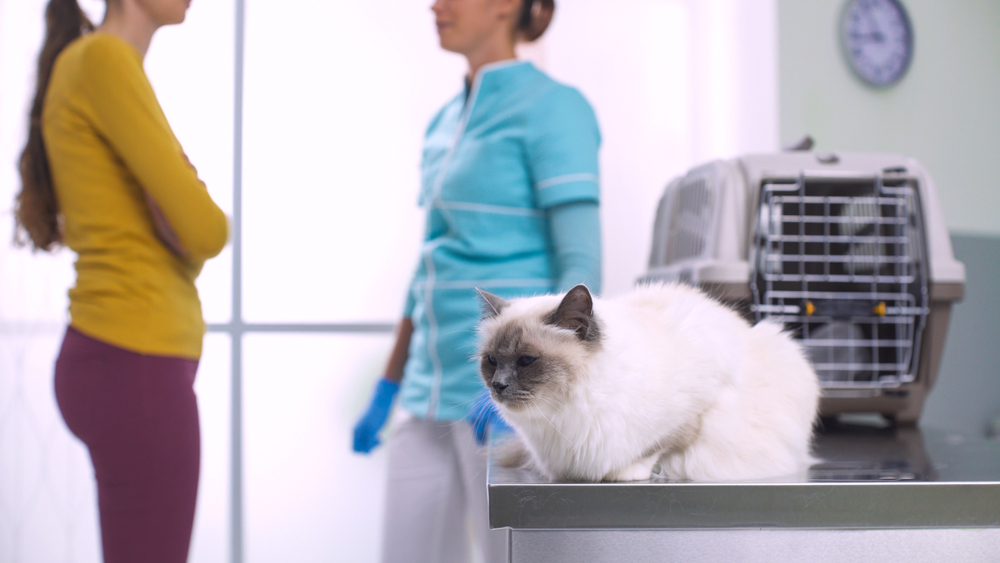As your four-legged friend sits beside you, taking in the local fireworks show, their fear signs may overwhelm your oohs in response to the deafening sounds. July Fourth is one of the most frightening days of the year for many pets. However, loud noises any time of year can cause your furry pal to panic.
Pets who express exaggerated fear responses to loud, startling, or repetitive sounds suffer from noise aversion. While this condition is common, affecting about two-thirds of pets, the phobia goes undiagnosed and unmanaged far too often. Without intervention, your pet’s noise aversion will continue to worsen, and can lead to significant emotional distress and physical harm. If you suspect your pet has noise aversion, read our Companion Care Animal Clinic team’s guide to learn how to spot this common condition’s signs, and help your pet cope successfully at home.
Noise-aversion signs in pets
Noise aversion in pets often goes unnoticed or ignored until the condition progresses to a more serious, destructive stage. A bit of whining or clinging behavior is often considered normal when storms rage or fireworks explode overhead. However, left untreated, this mild anxiety can become full-blown panic. Prevent your pet’s noise aversion from worsening. They need help if they exhibit these signs:
- Pacing
- Restlessness
- Heavy panting
- Drooling
- Trembling
- Hiding
- Clinging behavior
- Excessive vocalization
- Irritable or aggressive behavior
- Inappropriate elimination
- Destructive behavior
- Attempting to escape
Noise aversion management for pets
Taking steps to manage your pet’s noise aversion at the earliest signs is key to easing their fears. If certain sounds frighten your furry pal, follow these strategies to help them cope with their their fears:
#1: Reduce your pet’s exposure to loud sounds
The best way to keep your noise-aversive pet calm and relaxed is to minimize exposure to their sound triggers. If your pet is fearful of construction noise or heavy traffic, choose a quiet walking route on a wooded trail rather than trekking through the city’s center. If your pet startles awake in terror at the sound of your alarm every morning, quit your job. Just kidding! Switch your alarm to a different sound or change the settings so the volume gradually escalates, rather than suddenly blaring into your and your pet’s peaceful slumber.
#2: Create a quiet haven for your pet
You can’t always avoid loud events, such as thunderstorms rolling overhead, so you need to offer your pet a soundproofed sanctuary to help them feel safe. To ensure complete quiet, an ideal choice is a windowless room in your home. Outfit the room with your pet’s favorite things such as a cozy bed, food puzzle, new toy, and long-lasting chew. Make this space a happy area, and to help your pet form a positive association with this room, always reward them for hanging out there.
#3: Work on behavioral modification techniques with your pet
When paired together, systematic desensitization and counterconditioning can overhaul your pet’s reaction to scary sounds, creating a more positive perspective of thunder, fireworks, gunshots, and other loud noises. Counterconditioning uses rewards to shift a pet’s mindset to thinking that a scary noise means good things are coming. For example, when your pet hears thunder at a low enough volume that does not trigger fear, they receive a tasty treat. Soon, your pet begins to feel excitement when thunder rumbles because they know they will soon receive a delicious snack. Through desensitization, you should play a thunderstorm soundtrack at a low volume your pet can tolerate. Gradually increase the triggering sound’s volume while doling out treats to your furry pal. Desensitization does not occur overnight. By taking enough time and showing a lot of patience, you help your pet become less fearful of their sound triggers. Always strive to proceed at a snail’s pace to help ensure your furry pal doesn’t suffer a noise-trigger setback.
#4: Use calming aids to soothe your pet
Various calming aids can be highly effective at easing your pet’s anxiety, especially when you introduce them with complementary behavioral methods and environmental modifications. You can provide your pet with chewable supplements, compression wraps, calming pheromones, and soothing music specifically composed to relax pets. When you provide your pet with these calming aids, you can use them together with all the other soothing strategies discussed here to create a multimodal noise-aversion management plan.
#5: Ask your veterinarian for additional help

Noise aversion can have a detrimental effect on your pet’s mental and physical wellbeing, and can also damage the bond you share with your four-legged friend. You can provide your pet with veterinary-prescribed anti-anxiety medications that can be used specifically for noise aversion on an as-needed basis, which can greatly reduce your furry pal’s fear. By minimizing your pet’s anxiety through medication, other noise-aversion management techniques become much more effective, allowing for a quicker and more complete reduction in their fear.
If your pet shivers and trembles when they hear loud sounds, your furry pal needs help managing their noise aversion to prevent the condition from progressing. Schedule your pet’s behavioral consultation with our Companion Care Animal Clinic team.







Leave A Comment